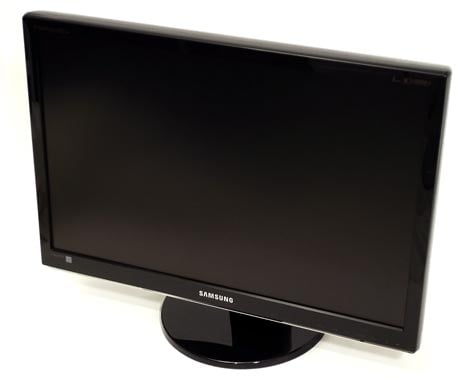Samsung SyncMaster 2493HM Widescreen Monitor
The price of LCD screens has steadily declined and in the last few years, larger monitors are starting to become relatively affordable. This is especially evident in the 19", 20" and 22" categories, where we see a significant number of products in the sub-$300 range. However 24" and larger screens still remained premium products until very recently. In the last year or so we have seen the first 24" screens to dip below the $400 mark appear on the market. The products in this new category of value oriented 24" screens almost universally combine a large and cheap TN panel with a basic monitor housing and stand to produce a cost effective product.
While these value oriented 24" monitors offer large screen size and high resolution (typically 1920x1200), they only have the most basic of features. Connectivity is often limited to just VGA and/or DVI and they are typically matched with a very simple stand with only limited tilt adjustment. Many models also suffer from low build quality. However, for the value conscious consumer, the sacrifices are well worth the cost reduction.
At first it would seem like Samsung's SyncMaster 2493HM is just another entry into the burgeoning sub-$400 24" monitor category. After all, it features a TN panel rather than the more expensive but better performing IPS, MVA and PVA panels found in high-end products like Samsung's own SyncMaster 245T. However, a look at the spec sheet reveals a feature set you would expect from a more expensive high-end monitor. Features like a 4-way adjustable stand, USB hub, built-in speakers and HDMI connectivity are well beyond what most other products in this category offer. Could this be a new break-away product or has Samsung skimped on other aspects in order to keep costs low? We have a Samsung SyncMaster 2493HM sample and we intend to find out.
|
| Display Size | 24" diagonal and viewable image |
| Display Type | Thin-Film Transistor LCD Active Matrix, TN panel |
| Display Viewing Angle | 160 degrees horizontal, 160 degrees vertical |
| Scanning Frequency | Horizontal: 30-81 KHz, Vertical: 56-75 Hz |
| Input Terminals |
D-sub, DVI-D and HDMI |
| Display Brightness | 400 cd/m2 (typical) |
| Native Resolution |
1920x1200 @ 60 Hz |
| Contrast Ratio | DC 10,000:1 (1000:1 static contrast ratio) |
| Display Color | 16.7 Million |
| Response Time | 5 ms |
| Pixel Pitch | 0.270 mm |
| Color Gamut | 82% |
| Power Source | Input Rating: 100 to 240V~ |
| Power Consumption | 100W in operating mode, <1.5W in sleep mode |
| Speakers | Built-in 4W (2W x 2 ch) Stereo Speakers |
| Stand | Height Adjustable, Pivot, Swivel, Tilt |
| Mounting | Standard VESA 4-hole 100 mm x 200 mm |
| Dimensions | 22.3 x 15.3 x 3.2 in. (566.4 x 388.6 x 81.3 mm) |
| Dimensions (with stand) | 22.3 x 17.6 x 9.9 in. (566.4 x 447.0 x 251.5 mm) |
| Weight | Monitor with Stand: 18.74 lbs. (8.50 Kg) |
| Emission Standard | EMC |
| Energy Star Compliant |
yes |
| RoHS Compliant |
yes |
| Included Accessories |
AC Power Cable, D-sub Cable, DVI Cable |
The Samsung SyncMaster 2493HM is being positioned as a multimedia monitor and this isn't surprising given its feature set. With the HDMI connection, built-in speakers, highly adjustable stand and USB hub, the 2493HM should be well equipped for most multimedia tasks. Other than the multitude of additional features, the rest of the specifications look fairly typical for a TN based LCD monitor.
The 2493HM's 82% color gamut and 160 degree viewing angle are underwhelming, although par for the course when it comes to TN panels. We can see right away that this monitor is not meant for serious graphics work. A typical screen brightness of 400 nits is fairly average for a screen of this size and so is the 5ms response time. Samsung also touts a dynamic contrast ratio of 10,000:1, which seems very high but dynamic contrast ratios are generally misleading and relatively meaningless. The 2493HM's static contrast ratio is a more believable 1000:1.
A native resolution of 1920x1200 should give plenty of desktop space for productivity work and allows for true HD playback as well as high resolution gaming. These are all excellent reasons why a large 24" is an attractive proposition.







